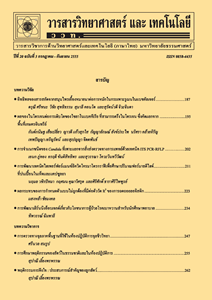การเกิดโคเอเซอร์เวตระหว่างเจลาตินและโพลีแซคคาไรด์ (กัมอะราบิก, กัมจากกากข้าวโพด และคาร์บอกซีเมทิลเซลลูโลส) ที่พีเอชต่าง ๆ
Main Article Content
Abstract
Abstract
Formation of coacervates gelatin (GE) and polysaccharides (gum arabic, GA; corn fiber gum, CFG; carboxymethyl cellulose, CMC) was studied. The mixtures of GE : GA (ratio 2 : 1), GE : CFG (ratio 1 : 1) and GE : CMC (ratio 1 : 1) at pH 2-7 was prepared. The formation of coacervates was investigated by measurements of turbidity at 600 nm and zeta-potential. The particle size distribution of coacervates at the highest turbidity value was also analyzed. The results showed that at high pH the turbidity of the mixtures were very low. As the pH decreased the turbidity was increased until it reached a maximum turbidity, after that decreased again to very low value and became transparent at pH 2. The pH that gave maximum coacervates was depended on types of mixture. The maximum coacervates occurred at pH 4.3, 4.4 and 3.1 for GE : GA, GE : CFG and GE : CMC, respectively and coacervates occurred at these pH were found to have zeta-potential value close to zero. GE : CFG showed the small size of coacervates (mean size 8.02 µm) of narrow size distribution. GE : GA gave the largest size of coacervates (mean size 69.15 µm) with a wide range of particle size. GE : CMC showed a wider range of particle size with a larger size than GE : CFG but smaller than GE : GA (mean size 32.88 µm).
Keywords: coacervate; gelatin; gum arabic; corn fiber gum; carboxymethyl cellulose
Article Details
References
[2] Weinbreck, F., Nieuwenhuijse, H., Robijn, G. and De Kruif, C.G., 2004, Complexation of Whey Proteins with Carrageenan, J. Agric. Food Chem. 52: 3550-3555.
[3] Gorji, S.G., Gorji, E.G. and Mohammadifar, M.A., 2014, Characteristic of gum traga-canth (Astragalus gossypinus)/sodium caseinate complex coacervation as a function of pH in an aqueous medium, Food Hydrocoll. 34: 161-168.
[4] Anvari, M. and Chung, D., 2016, Effect of cooling-heating rate on sol-gel transformation of fish gelatin-gum arabic complex coacervates phase, Int. J. Biol. Macromol. 91: 450-456.
[5] Cosgrove, T., Hone, J.H.E., Howe, A.M. and Heenan, R.K., 1998, A amallangle neutron scattering study of the structure of gelatin at the surface of polystyrene latex particles, Langmuir 14: 5376-5382.
[6] Lv, Y., Yang, F., Li, X., Zhang, X. and Abbas, S., 2014, Formation of heat-resistant nanocapsules of jasmine essential oil via gelatin/gum arabic based complex coacervation, Food Hydrocoll. 35: 305-314.
[7] Nakagawa, K. and Nagao, H., 2012, Microencapsulation of oil droplets using freezing-induced gelatin-acacia complex coacervation, Coll. Surf. A: Physicochem. Eng. Aspect. 411: 129-139.
[8] Comunian, T.A., Thomazini, M., Alves, A.J.G., De Matos Junior, F.E., De Carvalho Balieiro, J.C. and Favaro-Trindade, C.S., 2013, Microencapsulation of ascorbic acid by complex coacervation: Protection and controlled release, Food Res. Inte. 52: 373-379.
[9] Gomez-Estaca, J., Comunian, T.A., Montero, P. and Ferro-Furtado, R., 2016, Encapsulation of an astaxanthin-containing lipid extract from shrimp waste by complex coacervation using a novel gelatin-cashew gum complex, Food Hydrocoll. 61: 155-162.
[10] Dror, Y., Cohen, Y. and Yerushalmi-Rozen, R., 2006, Structure of gum arabic in aqueous solution, J. Polym. Sci. B: Polym. Phys. 44: 3265-3271.
[11] Yang, Y, Anvari, M., Pan, C.H. and Chung, D., 2012, Characterisation of interactions between fish gelatin and gum arabic in aqueous solutions, Food Chem. 135: 555-561.
[12] Schmitt, C., Sanchez, C., Thomas, F and Hardy, J., 1999, Complex coacervation between ß-lactoglobulin and acacia gum in aqueous medium, Food Hydrocoll. 13: 483-496.
[13] Doner, L.W., Chau, H.K., Fishman. M.L. and Hicks, K.B., 1998, An improves process for isolation of corn fiber gum, Cereal Chem. 75: 408-411.
[14] Kokubun, S., Yadav, M.P., Moreau, R.A. and Williams, P.A., 2014, Components responsible for the emulsification properties of corn fibre gum, Food Hydrocoll. 41: 164-168.
[15] He, F., Zhao, D., Liu, J. and Roberts, C.B., 2007, Stabilization of Fe-Pd nanoparticles with sodium carboxymethyl cellulose for enhanced transport and dechlorination of trichloroethylene in soil and groundwater, Indust. Eng. Chem. Res. 46: 29-34.
[16] Jain, A., Thakur, D., Ghoshal, G., Katare, O.P. and Shivhare, U.S., 2016, Characterization of microcapsulated ß-carotene formed by complex coacervation using casein and gum tragacanth, Int. J. Biol. Macromol. 87: 101-113.
[17] De Kruif, C.G. and Tuineir, R., 2001, Polysaccharide protein interactions, Food Hydrocoll. 15: 555-563.
[18] Turgeon, S.L., Beaulieu, M., Schmitt, C. and Sanchez, C., 2003, Protein-polysaccharide interactions: Phase-ordering kinetics, thermodynamic and structural aspects, Curr. Opin. Coll. Interf. Sci. 8: 401-414.
[19] Weinbreck, F., Nieuwenhuijse, H., Robijn, G.W. and De Kruif†, C.G., 2003, Complex formation of whey proteins: Exocellular polysaccharide EPS B40, Langmuir 19: 9404-9410.


